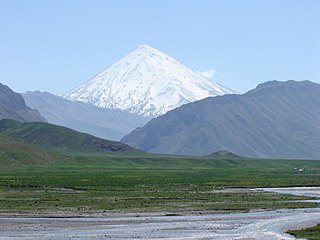 W
WʿAlam-Kūh – Mount Alam – is a mountain in Alborz mountain range in north of Iran, Mazandaran Province, forming a peak of Takht-e Suleyman Massif. It is located in Kelardasht District of Mazandaran Province of Iran. With an elevation of 4,805 meters, it is the second-highest peak in Iran after Mount Damavand.
 W
WThe Alborz range, also spelled as Alburz, Elburz or Elborz, is a mountain range in northern Iran that stretches from the border of Azerbaijan along the western and entire southern coast of the Caspian Sea and finally runs northeast and merges into the Aladagh Mountains in the northern parts of Khorasan. This mountain range is divided into the Western, Central, and Eastern Alborz Mountains. The Western Alborz Range runs south-southeastward almost along the western coast of the Caspian Sea. The Central Alborz runs from west to east along the entire southern coast of the Caspian Sea, while the Eastern Alborz Range runs in a northeasterly direction, toward the northern parts of the Khorasan region, southeast of the Caspian Sea. Mount Damavand, the highest mountain in Iran measuring 5,610.0 m, is located in the Central Alborz Mountains.
 W
WAzad Kuh is one of the highest peaks in the central Alburz Range in Mazandaran province north of Iran. In Persian Kuh means mountain and Azad means free, so Azad Kuh can be translated to The Free Mountain. This name is probably chosen by local people because of Azad Kuh's cone like shape and the fact that it is not connected to its surrounding peaks.
 W
WThe Alborz range, also spelled as Alburz, Elburz or Elborz, is a mountain range in northern Iran that stretches from the border of Azerbaijan along the western and entire southern coast of the Caspian Sea and finally runs northeast and merges into the Aladagh Mountains in the northern parts of Khorasan. This mountain range is divided into the Western, Central, and Eastern Alborz Mountains. The Western Alborz Range runs south-southeastward almost along the western coast of the Caspian Sea. The Central Alborz runs from west to east along the entire southern coast of the Caspian Sea, while the Eastern Alborz Range runs in a northeasterly direction, toward the northern parts of the Khorasan region, southeast of the Caspian Sea. Mount Damavand, the highest mountain in Iran measuring 5,610.0 m, is located in the Central Alborz Mountains.
 W
WThe Hotu and Kamarband Caves or Belt Caves are prehistoric, archaeological sites in Iran. They are located 100 m (330 ft) apart, in a cliff on the slopes of the Alborz mountains in the village of Tarujen, 5 km (3.1 mi) south west of Behshahr.
 W
WMian-Seh-Chal is a mountain in the Takht-e Suleyman Massif, Alborz mountain range, north of Iran.
 W
WMiyānkāle peninsula is a long, narrow peninsula in Behshahr County of Māzandarān Province in the north of Iran situated in the extreme south-eastern part of the Caspian Sea. The elongate peninsula is 48 kilometres long, and between 1.3 and 3.2 kilometres wide.
 W
WMount Damavand, a potentially active volcano 5600-m high, is a stratovolcano which is the highest peak in Iran and the highest volcano in Asia. Damāvand has a special place in Persian mythology and folklore. It is in the middle of the Alborz range, adjacent to Varārū, Sesang, Gol-e Zard, and Mīānrūd. It is near the southern coast of the Caspian Sea, in Amol County, Mazandaran Province, 66 km (41 mi) northeast of the city of Tehran.
 W
WTakhte Soleyman or Takht-e Suleyman is a mountain in the Takht-e Suleyman Massif, Alborz mountain range, north of Iran.
 W
WShaneh-Kuh is a mountain in the Takht-e Suleyman Massif, Alborz mountain range, north of Iran.
 W
WSiah-Kaman is a mountain in the Takht-e Suleyman Massif, Alborz mountain range, north of Iran.
 W
WSialan is a mountain peak in Alborz range in Iran. This mountain peak is located at altitude of 4,250 metres (13,940 ft) and overlooks to the valley of Duhezar and Daryasar plain in Tonekabon county from the north and overlooks to the Alamut valley and Heniz in Qazvin County from the south.